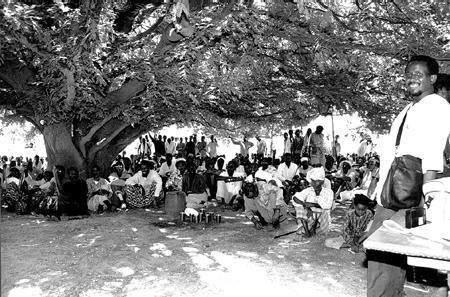thank you Ugas Gadid Rest in peace

Gurgura :
Gurgura is one of the four woredas in the chartered of Dire Dawa in Ethiopia. It is named for an ethnic group which lives in the area, the Gurgura; because there are records of a subgroup of the Nole Oromo with that name, as well as a sub-clan of the Somali Dir MADAXWEYNDIR, it is unclear which one of these groups this woreda is named for. The administrative center of Gurgura is MAGAALA JABTI
The woreda of Gurgura was in existence as early as 1964, when its administrative center was at Kersa. Following the end of the Ethiopian Civil War, it was the only woreda without a zone or a kilil because the federal government did not want Dire Dawa to be surrounded by the Somali State and the Somali Gurguras did not want to be part of Oromia. In the end it became part of DIRE DAWA COUNCEL STATE
Demographics :
Based on figures published by the Central Statistical Agency in 2005, this woreda has an estimated total population of 116,250, of whom 58,004 are men and 58,246 are women; 14,250 or 12.26% of its population are urban dwellers, which is less than the average for entire chartered city of 74.4. With an estimated area of 1,195.52 square kilometers, Gurgura has an estimated population density of 97.2 people per square kilometer, which is less than the average for the administrative region of 328.
The 1994 national census reported a total population for this woreda of 87,013 in 15,827 households, of whom 45,098 were men and 41,915 were women; 8,337 or 9.58% of its population were urban dwellers. The three largest ethnic groups reported in Gurgura were the Oromo (61.48%), the Somali (36.53%), and the Amhara (1.24%); all other ethnic groups made up 0.75% of the population. Oromiffa is spoken as a first language by 62.29%, 35.77% Somali and 1.39% speak Amharic; the remaining 0.55% spoke all other primary languages reported. The majority of the inhabitants were Muslim, with 98.34% of the population reporting that as their faith, while 0.48% practiced Ethiopian Orthodox Christianity. Concerning education, 7.98% of the population were considered literate. Concerning sanitary conditions, 90% of the urban houses and 31% of all houses had access to safe drinking water at the time of the census; 37% of the urban and about 7% of the total had toilet facilities.

Distribution The Gurgura are of the Madahwein Dir, making them directly related to the Gurre and Gariire and other Madahwein Dirs.[1] They also have lineal ties with the Issa, Gadabursi, Biimaal, Bajimal, Quranyow-Garre, Surre, Madigan, and other Dir subclans.[1][2]
History The city of Dire Dawa was originally called Dir Dhabe and used to be part of Adal Sultanate during the medieval times and was exclusively settled by Dir clan which is a major Somali tribe and after the weakening of Adal Sultanate, the Oromos took advantage and were able to penetrate through the city and settle into these areas and also assimilate some of the local Gurgura clan.[3]
Oromo political organizations sought to coerce the Gurgura, (who's identity was very contentious for the city of Dire Dawa) who largely speak the Oromo language (Oromiffa), to identify themselves as Oromo, though they belong to the Dir clan family of the Somalis. Oromo political organizations claimed that "the Gurgura people who speak Oromiffa belong to the Oromo nation and they only started to identify themselves with the Somali after the 1974 change of the Haile Selassie regime".[4] This is false since the Gurgura are mentioned in the Futuh Al Habasha : Conquest of Abyssinia as source dating back as far as the 16th century, by author: Shihabudin Ahmad bin Abd al-Qadir 'Arab Faqih or 'Arab Faqih. It is recorded that the Gurgura were Somalis who fought alongside Ahmed Gran or Ahmad ibn Ibrahim al-Ghazi with knights, spear-men and foot-soldiers and their leader Garād 'Abd.[5]
Many prominent Gurgura in Dire Dawa, including traditional leaders, have identified themselves either Oromo or Somali. Since 1991, majority of them identify themselves as Somalis though we have still others that identify themselves as Oromos. [6]
References
- Lewis, I. M. (1998). Peoples of the Horn of Africa: Somali, Afar and Saho. Red Sea Press. ISBN 9781569021057.
At the end of the book "Tribal Distribution of Somali Afar and Saho"
- Verdier, Isabelle (1997). Ethiopia: the top 100 people. Indigo